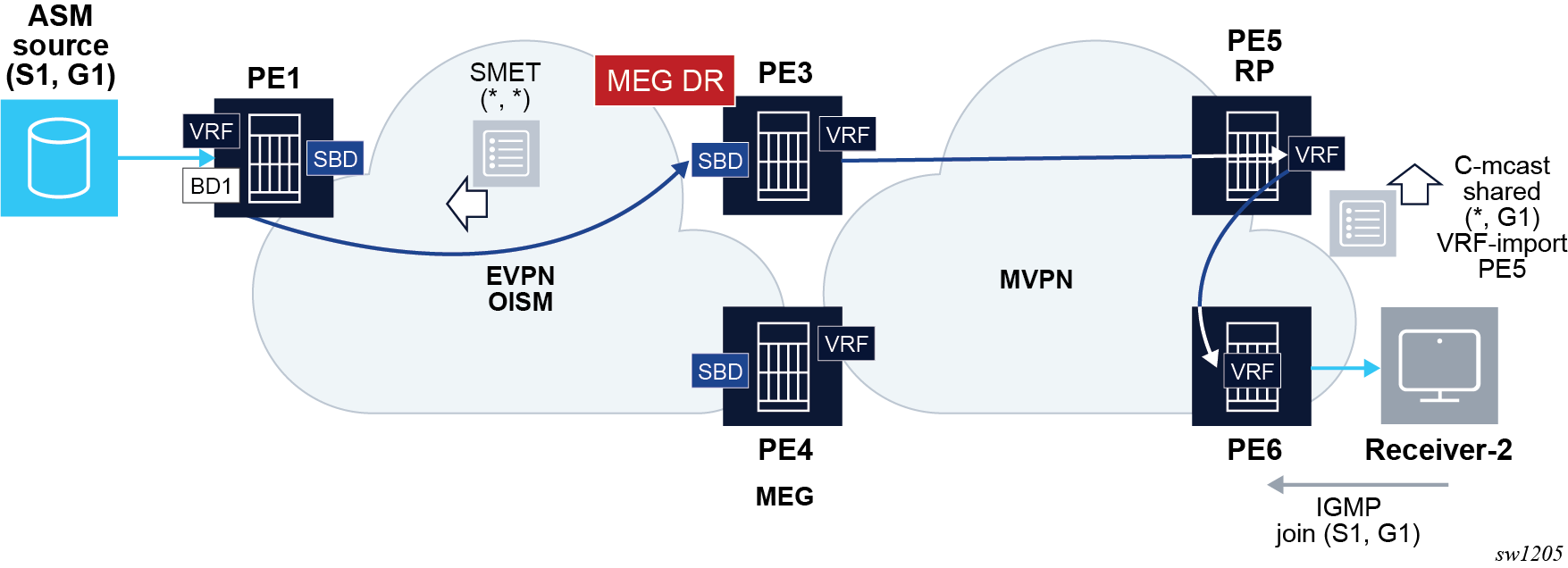When Any-Source Multicast (ASM) group sources in the EVPN OISM domain, the MEG DR for the SBD needs to attract the ASM traffic from the EVPN sources and initiate the MVPN register and source discovery procedure. This is homologous to a PIM DR and its First Hop Router (FHR) function, and the scenario is shown in the following figure.
To attract ASM source traffic and act as the FHR, the MEG DR performs the following steps:
-
The MEG DR generates a wildcard SMET route.
- The wildcard SMET route is automatically generated as soon as the MEG is elected as DR. The wildcard SMET route is formatted in accordance with RFC 6625, with address and length equal to zero.
- In addition, to attract multicast traffic from ASM sources on the non-DR routers, the user can configure the config>service>vpls(sbd)>allow-ip-int-bind>evpn-mcast-gateway>non-dr-attract-traffic command in the SBD. The command triggers the advertisement of the wildcard SMET route from the non-DR routers.
-
When the MEG DR (for example, PE3 in Figure: ASM sources in the EVPN network ) receives the ASM multicast traffic, it is handled as follows:
- Assuming the MEG DR does not have the Layer 3 multicast state for it, the multicast traffic, (S1,G1) in the example shown in Figure: ASM sources in the EVPN network, is sent to the CPM.
- The CPM encapsulates the multicast traffic into unicast register messages to the RP. For example, PE5 decapsulates the traffic and sends the multicast traffic down the shared tree.
- In MVPN, PE5 triggers Source A-D routes and a C-multicast route for (S1,G1), and the SPT switchover occurs.
-
If the MEG non-DR (for example, PE4) receives the ASM multicast traffic, it is handled as follows:
- Assuming the MEG DR does not have the Layer 3 multicast state for it, the multicast traffic, (S1,G1) in the example shown in Figure: ASM sources in the EVPN network, is sent to the CPM and discarded.
- The multicast traffic is heavily rate limited in the CPM.

- On the remote OISM PEs attached to the ASM source (for example, PE1), the PE creates
an MFIB for (*,*) with OIFs for the MEGs that sent the wildcard SMET route. For
example:
- (*,*) OIF: evpn-dest-PE3 (assuming non-dr-attract-traffic false)
- (*,*) OIF: evpn-dest-PE3, evpn-dest-PE4 (assuming non-dr-attract-traffic true)
- Any multicast traffic is forwarded based on the MFIB for (*,*).
- The preceding handling also applies to ASM sources attached to the non-DR MEG or PEG. The non-DR creates an EVPN destination (on the BD attached to the source) to the DR as OIF for (*,*).